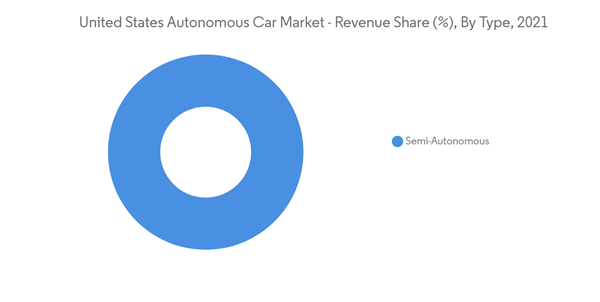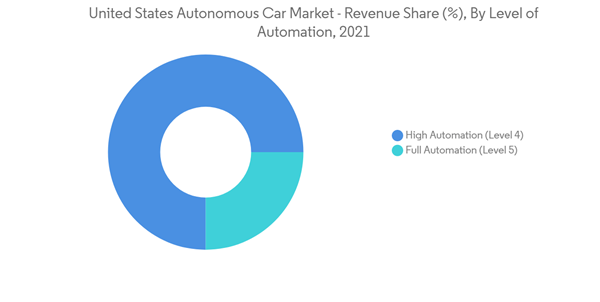The ongoing COVID-19 pandemic has hit the overall automotive industry, compelling automakers to cut down the output at their production plants. COVID-19 has also impacted many OEM operations, from production to R&D, creating short-term disruption and delaying autonomous vehicle development and rollouts.
Over the medium term, with stringent regulations by the government focused on increasing road safety, more autonomous vehicles are being developed with highly advanced technologies integrated with smartphones through the internet creating new interest among market players to attract customers. Due to rising health concerns and changing commuting patterns, the demand among private consumers is also increasing for personal cars. According to Euromonitor's Voice of the Industry survey, 13% of respondents indicated they plan to increase the usage of cars for commuting short distances permanently.
Level 4 and Level 5 (as scaled by SAE) autonomous cars may not reach wide acceptance by 2030. However, there would be rapid growth for Level 2 and Level 3 autonomous cars, which have advanced driver assistance systems, like collision detection, lane departure warning, and adaptive cruise control.
The demand for self-driving cars in the United States region has increased significantly over the past three years. The demand is well supported by the collaboration between the companies across the United States. For instance,
In April 2021, Velodyne Lidar announced that it had been selected by Faraday Future (FF) as a lidar supplier for Faraday's FF 91 all-electric vehicle. Velodyne's solid state Velarray H800 lidar sensors will power the FF 91's autonomous driving system to deliver various autonomy features. Velarray H800 is a solid state lidar sensor that combines long-range perception and a broad field of view for safe navigation and collision avoidance in ADAS and autonomous mobility applications.
Apart from the points above, Mexico's new trade agreement with the United States and Canada has involved opportunities for the transfer of autonomous technology. However, there is room for improvement in infrastructure in the coming years.
US Autonomous Car Market Trends
Growing Adoption of Autonomous Cars to Drive Demand in the Market
The United States autonomous car market will be dominated by the semi-autonomous vehicle, as the need for ease in driving and the increasing concern for safety and security are surging the demand for high-end technology.The contributing factors in the market growth are the need for safe and efficient driving options, evolution in the connected car technology, increasing research and development in the autonomous car sector, and government support for these cars in terms of policies and rebates.
According to the NHTSA (National Highway Traffic Safety Administration), about 94% of the accidents occurring on US roadways can be attributed to human errors, like drunken driving and speeding. These can be mitigated with an autonomous car, whose functionality may follow the speed regulations stated in particular areas.
The market is expected to witness growth due to the rapid digitization of connected cars, which adds to their demand. The two necessary components of vehicle autonomy - vehicle-to-vehicle and vehicle-to-infrastructure connectivity - can be more easily integrated into connected cars than conventional ones.
OEM competitive rivalry has led to significant developments in this technology to cater to the ever-increasing demand from the public. For instance, Tesla, over a few months in 2021, has released a Fully Self Driving (FSD) update over the air to a majority of its vehicle owners, leading to a kickstart of using fully autonomous vehicles.
Various startups working in the level 4 cars are getting new funding to accelerate their operation. For instance,
In May 2021, We Ride, a level 4 autonomous driving mobility startup, announced the completion of Series C funding. New investors included IDG Capital, Costone Capital, Cypress Star, Sky9 Capital, and K3 Ventures, while CMC Capital, QimingVenture Partners, and other early investors also participated in the funding.
In April 2021, We Ride was granted a fully unmanned driving test license by the California Department of Motor Vehicles, United States.
Owing to such intense competitive rivalry and other factors involving different types of vehicle automation, the demand for fully autonomous vehicles in the United States is expected to witness significant growth during the forecast period.
Demand for Conditional Automation Expected to Rise Over Forecast period
By the level of automation, the United States autonomous car market is dominated by conditional automation (Level 3). In Level 3 automation, the autonomous vehicle driving system performs all the dynamic driving tasks, expecting the human driver to respond appropriately to the request to intervene. The dynamic driving task includes steering, braking, accelerating, monitoring the vehicle, and responding to events happening on the road.Self-driving cars have already been tested and used in California, Texas, Arizona, Washington, Michigan, and other states. However, their mobility is restricted to specific test areas and driving conditions. Audi is the first company to develop a Level 3 autonomous car by launching the Audi A8 in the market. However, there are a few limitations for Level 3 autonomous cars, such as constant awareness needed from the driver. Thus, this makes Level 3 automation less dependable.
In 2022, German automaker Mercedes-Benz will be the world's first to gain internationally valid regulatory approval in producing vehicles capable of Level 3 autonomous or "conditionally automated" driving. Mercedes-Benz's updated Drive Pilot system can take over the driving chores while the vehicle is traveling at the legally permitted speed of 37 mph (60 kph).
Consequently, several automotive manufacturers are pushing directly for level 3 autonomous cars, and various technology companies in the country are reaching new milestones in terms of total miles tested. Such developments across the United States are expected to drive demand in the market.
US Autonomous Car Industry Overview
The United States autonomous car market is consolidated and is dominated by a few players, such as Apple, Waymo, Tesla, Ford, Honda, BMW, Nissan, Intel, and Uber. These players have also encompassed brand reinforcement, innovation, collaboration, and M&A strategies to gain a higher competitive share. For instance,In December 2021, Aurora launched a pilot program with Uber Technologies Inc. to transport goods autonomously across Texas. The company aims to launch its autonomous commercial trucking by 2023.
In February 2021, Aurora announced that it entered a strategic collaboration with Toyota and Denso to build and deploy self-driving cars on a large scale. The collaboration will develop and test driverless vehicles equipped with the Aurora Driver, starting with the Toyota Sienna. By the end of 2021, companies expect to begin testing an initial Siennas fleet.
Additional Benefits:
- The market estimate (ME) sheet in Excel format
- 3 months of analyst support
This product will be delivered within 2 business days.
Table of Contents
Companies Mentioned (Partial List)
A selection of companies mentioned in this report includes, but is not limited to:
- Waymo LLC
- Tesla Inc.
- Ford Motor Company
- Honda Motor Company Ltd
- Bayerische Motoren Werke AG (BMW)
- Intel Corporation
- Uber Technologies Inc.
- Apple Inc.
- Nissan Motor Corporation










